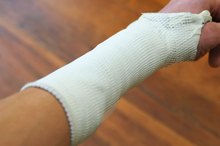How to Remove a Cast
It is not recommended that you remove a cast on your own. Many people have removed casts without a doctor's supervision 1. While many of these do-it-yourself procedures go without mishap, there's a real risk of danger. Be prepared to ask for help, because a steady hand is needed to remove a cast safely. The do-it-yourself method of cast removal has evolved over the years 1. Gone are the days of using a hacksaw or handsaw. Nowadays, tools are sold for general woodworking that resemble the tools your practitioner would use. Although not as safe as a doctor's hands, these tools reduce the risk of serious injury when used properly.
Fold a towel and place it far down in the opening of the cast. Try to place as much material as possible between the cast and skin. Reposition the towel throughout the cast cutting process as a guard.
Knots Used to Repair Fishing Net
Learn More
Put on a face mask to reduce inhalation of fiberglass or plaster particles.
Use a hand-held rotary tool with a small cutting wheel to lightly cut the surface of the cast. The goal is to remove the casting material without touching the cotton material underneath.
How to Paint Asbestos Siding
Learn More
Remove 1/8-inch pieces of the casting material in a straight line from top to bottom. Work steadily and slowly to reduce the risk of injury.
Make similar cuts on either side of the first cuts to weaken the cast material. Do not cut through the cast completely with the rotary cutter. Make sideways cuts every six-inches to remove the casting material in several pieces.
Cut down the length of the cast and on the top of any curves. Cut around the bend on ankles, elbows and feet. Remove the protective towel when finished with the rotary cutter.
Slide the kitchen shears slowly under the cotton material. Cut through the batting material with a pair of sharpened kitchen shears. Shears have strong cutting blades that will cut through any casting material left behind.
Make slow, precise cuts to reduce the risk of further injury. Cut down to the first sideways cut and follow the rotary cut all the way around. Remove each section of cast and continue working on until the cast is removed.
Tips
Ask a steady hand for help.
Use a small, slim cutting disk on the rotary cutter.
Consider buying proper cast cutting shears.
Warnings
Do not pry on the casting material.
Do not cut too deeply with the rotary cutter.
Do not try to pull out the limb before the cast is removed.
Do not cut with unsharpened shears.
Do not remove a cast before the limb has healed.
Related Articles
References
Tips
- Ask a steady hand for help.
- Use a small, slim cutting disk on the rotary cutter.
- Consider buying proper cast cutting shears.
Warnings
- Do not pry on the casting material.
- Do not cut too deeply with the rotary cutter.
- Do not try to pull out the limb before the cast is removed.
- Do not cut with unsharpened shears.
- Do not remove a cast before the limb has healed.
Writer Bio
Dakota Wright is a freelance journalist who enjoys sharing her knowledge with online readers. She has written for a variety of niche sites across the Internet including “Info Barrel and Down Home Basics.” Her recent work can be seen in “Backwoods Home Magazine.”









